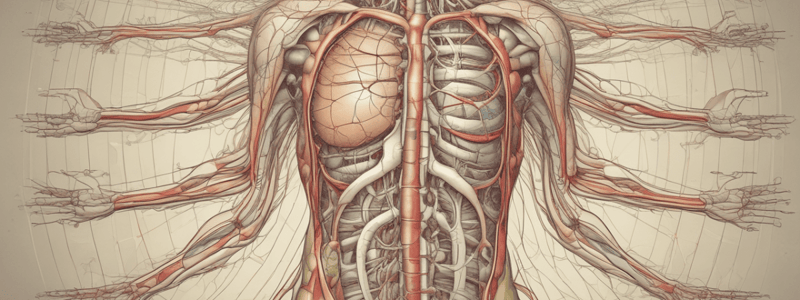Podcast
Questions and Answers
What is the effect of Protein Kinase A phosphorylation on L-type Ca2+ channels?
What is the effect of Protein Kinase A phosphorylation on L-type Ca2+ channels?
- Decrease the conduction velocity of L-type Ca2+ channels
- Inactivate L-type Ca2+ channels
- Increase the refractory period of L-type Ca2+ channels
- Activate L-type Ca2+ channels (correct)
What is the consequence of severe PNS stimulation on the heart?
What is the consequence of severe PNS stimulation on the heart?
- Heart block (correct)
- Increase in heart rate
- Increase in contractility
- Increase in conduction velocity
Which receptor is stimulated by norepinephrine in the heart?
Which receptor is stimulated by norepinephrine in the heart?
- Muscarinic (M2) receptor
- β2 adrenergic receptor
- β1 adrenergic receptor (correct)
- α1 adrenergic receptor
What is the effect of Acetylcholine on L-type Ca++ channels in the atria?
What is the effect of Acetylcholine on L-type Ca++ channels in the atria?
What is the effect of SNS on the effective refractory period?
What is the effect of SNS on the effective refractory period?
Which of the following is an exception to sympathetic innervation of blood vessels?
Which of the following is an exception to sympathetic innervation of blood vessels?
What is the effect of PNS on the conduction velocity of the AV node?
What is the effect of PNS on the conduction velocity of the AV node?
What is the result of PKA phosphorylation on the AV nodal cells?
What is the result of PKA phosphorylation on the AV nodal cells?
Which of the following nerve fibers are responsible for the parasympathetic innervation of the ventricles?
Which of the following nerve fibers are responsible for the parasympathetic innervation of the ventricles?
Which of the following is NOT a function of the autonomic nervous system (ANS) in relation to the cardiovascular system?
Which of the following is NOT a function of the autonomic nervous system (ANS) in relation to the cardiovascular system?
What is the effect of sympathetic stimulation on the SA node phase 4?
What is the effect of sympathetic stimulation on the SA node phase 4?
Which of the following receptors are stimulated by acetylcholine in the parasympathetic innervation of the heart?
Which of the following receptors are stimulated by acetylcholine in the parasympathetic innervation of the heart?
Which of the following is an effect of parasympathetic stimulation on the heart rate?
Which of the following is an effect of parasympathetic stimulation on the heart rate?
What is the origin of the fibers from the sympathetic nervous system (SNS) that innervate the heart?
What is the origin of the fibers from the sympathetic nervous system (SNS) that innervate the heart?
Which of the following is a positive dromotropic effect of sympathetic stimulation on the heart?
Which of the following is a positive dromotropic effect of sympathetic stimulation on the heart?
Which of the following types of nerve fibers are involved in both sympathetic and parasympathetic nervous systems?
Which of the following types of nerve fibers are involved in both sympathetic and parasympathetic nervous systems?
Flashcards are hidden until you start studying
Study Notes
Location of Autonomic Nervous System (ANS)
- Sympathetic nervous system (SNS) originates from thoracolumbar outflow (T1-L2)
- Parasympathetic nervous system (PNS) originates from craniosacral outflow (CN III, VII, IX, X, S2-S4)
ANS and Cardiovascular System (CVS)
- ANS controls heart rate, force of contraction, and peripheral resistance
- ANS does not initiate electrical activity in the heart
Innervation of the Heart
- PNS innervation:
- Originates from vagal motor nuclei
- Travels through right and left vagal nerves to the thoracic cavity
- Synapses with postganglionic parasympathetic neurons within the myocardium
- Innervates SA node, AV node, and little to none of the ventricles
- SNS innervation:
- Originates from T1-T5
- Synapses at paravertebral sympathetic ganglia
- Postganglionic fibers run with great vessels to reach the heart
- Innervates ventricles, atria, SA node, and AV node
Chronotropic Effects
- SNS:
- Positive chronotropic effect: increases heart rate by increasing the slope of SA node phase 4
- Norepinephrine stimulates β1 adrenergic receptors, activating funny Na+ channels
- PNS:
- Negative chronotropic effect: decreases heart rate by decreasing the slope of SA node phase 4
- Acetylcholine stimulates muscarinic (M2) receptors, inactivating funny Na+ channels and activating outward flow of K+ currents
Dromotropic Effects
- SNS:
- Positive dromotropic effect: increases conduction velocity through AV node
- Activates L-type Ca++ channels, increasing calcium uptake and phosphorylating L-type Ca2+ channels
- Shortens effective refractory period
- PNS:
- Negative dromotropic effect: decreases conduction velocity through AV node
- Inactivates L-type Ca++ channels, prolonging effective refractory period
- Can lead to heart block if severe
Inotropic Effects
- SNS:
- Positive inotropic effect: increases contractility of the heart
- Norepinephrine stimulates β1 adrenergic receptors, activating L-type Ca++ channels
- PNS:
- Negative inotropic effect: decreases contractility of the heart
- Acetylcholine stimulates muscarinic (M2) receptors, inactivating L-type Ca++ channels
Autonomic Effects on Vasculature
- Most blood vessels receive sympathetic innervation
- Exceptions include some blood vessels that do not receive SNS innervation
Studying That Suits You
Use AI to generate personalized quizzes and flashcards to suit your learning preferences.




